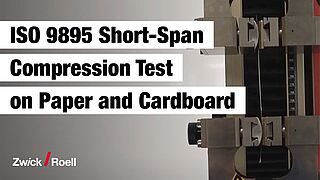ISO 1924 | ASTM D828 | Tappi T494 tensile test on paper
ISO 1924 describes the tensile test on dry paper and cardboard used to measure tensile strength, stress at break, and tensile energy absorption.
ISO 1924-2 specifies the tensile testing of paper with a test length of 180 mm (distance between the grips) using a materials testing machine under a constant strain rate (20 mm/min). It applies to all paper and cardboard as well as to the components of corrugated board, but not to the corrugated board itself, and is the most widely used standard for measuring width-related force at break, strain at break, tensile energy absorption, tensile stiffness, and modulus of elasticity.
ISO 1924-3 specifies a faster method with a higher strain rate of 100 mm/min and a test length of 100 mm to determine the tensile properties. The method also considers the tensile strength and the tensile strength index in addition to the characteristic values as defined in ISO 1924-2. The strain is also recorded with greater accuracy. It is mainly used when a larger number of specimens need to be tested in a given time.
Standards ASTM D828 and TAPPI T494 are also important test methods used to determine the tensile strength of paper and cardboard. They are used primarily in the North American paper industry.
ZwickRoell provides the appropriate test equipment for all of these paper tensile test standards to ensure reliable, standard-compliant test results.
Test equipment Video Differentiation from other standards Request a consultation
Test equipment for ISO 1924, ASTM D828 and Tappi T949
The strength of the paper material determines which materials testing machine to use. However, most paper tensile tests require much less than 5 kN, making a single-column zwickiLine universal testing machine a good choice.
As per the standard, pneumatic grips are the preferred clamping solution for paper testing. The pneumatic gripping pressure can be easily adjusted to prevent specimen damage and slippage. Alternatively, our screw grips, which can also be adjusted manually with precision, are suitable.
Our testXpert testing software is user-friendly and customizable. It provides all the necessary calculations and statistics for tests performed according these paper standards, including tensile energy absorption (TEA). In many cases the only result to be determined is the tear strength or tear length, superfluous results can be hidden by the software. The testXpert testing software accomplishes this by means of two functional levels.
- Standard test programs (to ISO 1924-2, ISO 1924-3, ASTM D828 or TAPPI T494) contain only test sequences and test results which are stipulated in test standards.
- Changing to Master functionality provides access to all the program's capabilities, ensuring the necessary functional scope for future tests.
If required, change in length and width can be measured directly with videoXtens.
Differentiation from other tensile tests for paper, cardboard, and tissue
| Short description | Standards |
|---|---|
| Paper & cardboard | Wet strength / wet tensile test |
|
| Paper & cardboard | Tensile test dry |
|
| Paper | Zero-span tensile strength |
|
| Paper & cardboard | Internal bond test / Z-direction tensile test |
|
| Paper | Tissue | Wet tensile strength |
|
| Paper | Tissue | Tensile test dry |
|
Video: determining the compressive and tensile strength of paper
This video shows how to determine the compressive strength of paper by performing a short-span compression test (SCT) according to ISO 9895 and DIN 54518 and a tensile test on paper according to ISO 1924-3 using a materials testing machine with two test areas, pneumatic grips, and the testXpert testing software.

